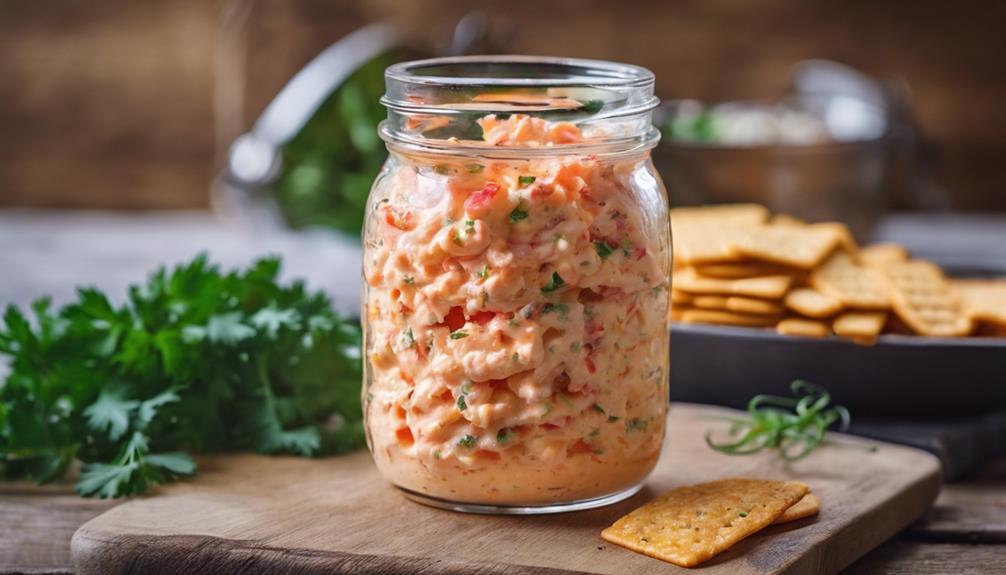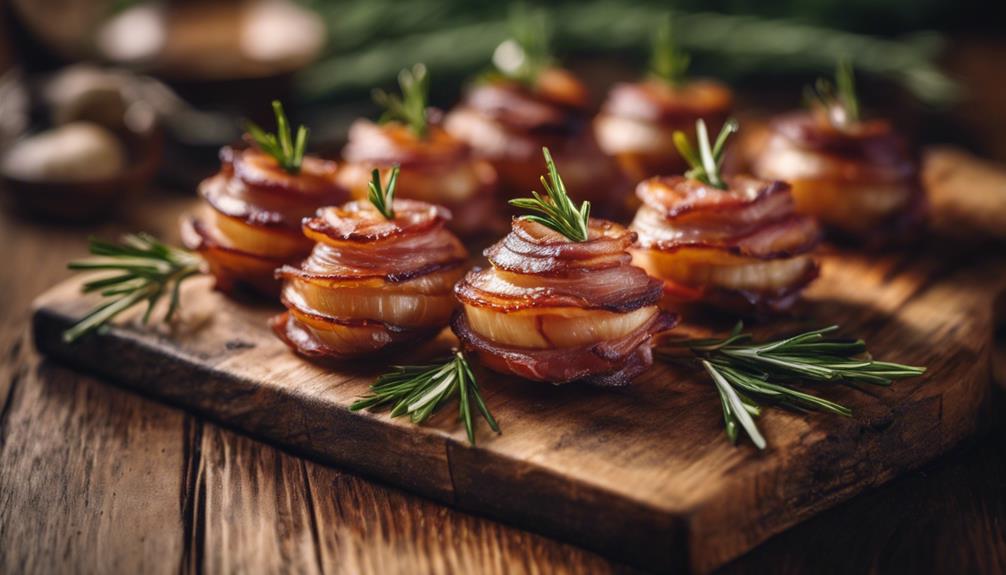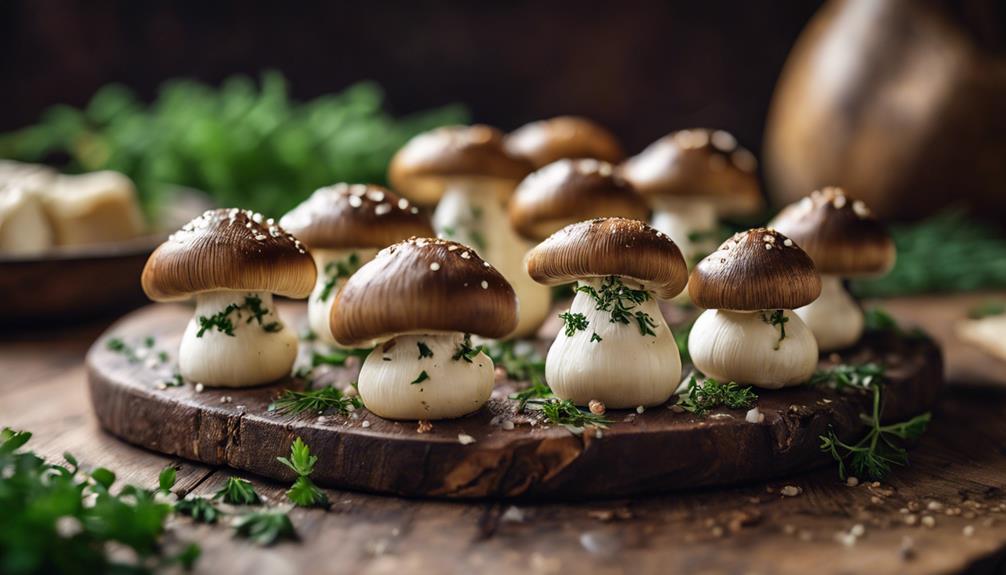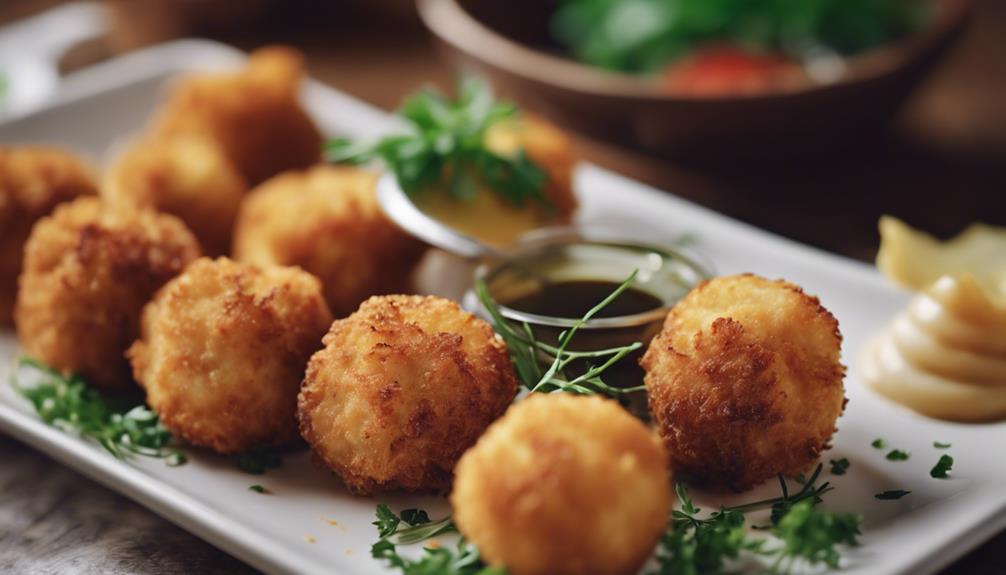Indulge in the rich and tangy delight that is Pimento Cheese, a beloved favorite that dates back to early 20th-century America. This Southern classic combines Cheddar cheese, mayonnaise, cream cheese, and pimentos for a delicious experience with a hint of nostalgia. The choice of medium to mild cheddar and the incorporation of diced or roasted pimentos are essential in creating its unique flavor. Enjoy a burst of flavors from ingredients such as garlic powder and cayenne pepper, which enhance the traditional recipe. Explore homemade variations and different serving options to discover a world of culinary possibilities.
Key Takeaways
- Traditional Southern dish with Cheddar, mayo, cream cheese, and pimentos.
- Creamy texture from whipped cream cheese and richness from mayo.
- Tangy flavor profile from diced pimentos or roasted red bell peppers.
- Versatile spread for sandwiches, crackers, veggies, or grilled cheese.
- Blend of sharp cheddar, mayo, cream cheese, and spices like cayenne.
Pimento Cheese Origin
Pimento cheese, with its roots firmly planted in Southern cuisine, has a rich and flavorful history that dates back to early 20th-century America. This iconic spread is a harmonious blend of Cheddar cheese, mayonnaise, cream cheese, and pimentos, creating a creamy and tangy concoction that has become synonymous with Southern comfort food. Initially known as the 'pâté of the South,' pimento cheese quickly gained popularity due to its versatility and delicious taste.
In the early 1900s, Southern households embraced this simple yet delectable dish, incorporating it into various recipes and serving it on social occasions. The combination of sharp Cheddar cheese, smooth cream cheese, the subtle tang of mayonnaise, and the sweet flavor of pimentos proved to be a winning formula that transcended regional boundaries.
Over time, pimento cheese evolved from a humble Southern staple to a beloved spread enjoyed nationwide for its unique and irresistible flavor profile.
Key Ingredients in Pimento Cheese
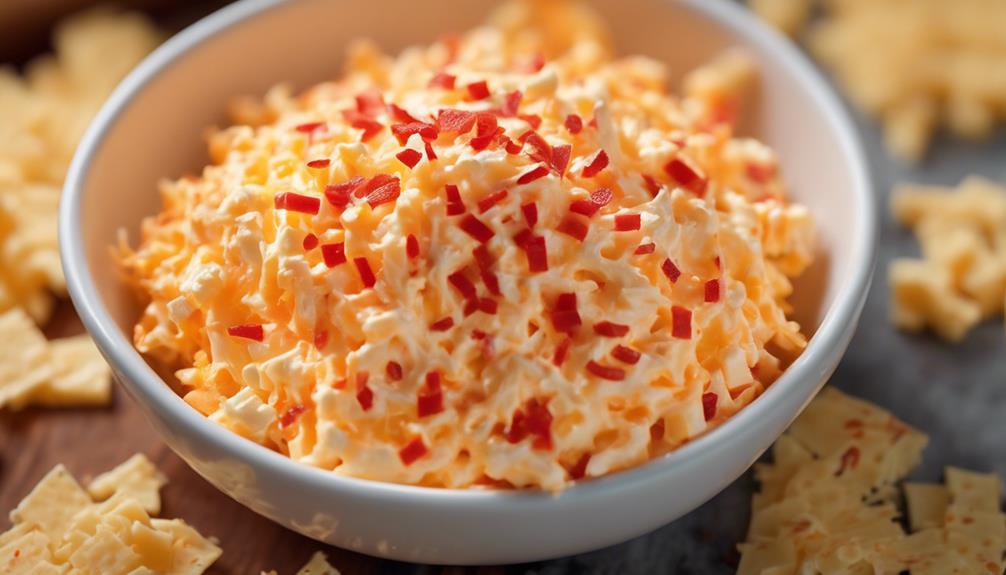
Pimento cheese requires a combination of key ingredients to achieve its signature flavor profile. Starting with cream cheese for a smooth base, mayonnaise is then added for tanginess and moisture.
Sharp cheddar cheese, diced pimentos, and a blend of spices like garlic powder and cayenne pepper round out the components that make this Southern favorite so delectable.
Cheese Selection Tips
For a well-rounded flavor in your pimento cheese, opt for medium to mild cheddar cheese as the key ingredient. The cheddar cheese brings a rich and creamy taste that pairs perfectly with the other elements of the dish.
When selecting the peppers for your pimento cheese, consider using jarred pimentos or diced roasted red bell peppers. These ingredients provide the signature tangy sweetness that complements the cheese.
To achieve a smoother consistency and make the mixing process easier, whipped cream cheese is a great choice to incorporate into your recipe.
Additionally, choosing the right mayonnaise is essential for flavor and creaminess. Dukes Mayonnaise, a popular brand, is recommended, although you can use your preferred brand to suit your taste preferences.
For a sweet and spicy kick, pickled jalapeños like Trader Joe's Hot & Sweet variety can be a flavorful addition to your pimento cheese.
Pimento Addition Techniques
When crafting pimento cheese, it's essential that your selection of peppers, whether jarred pimentos or roasted red bell peppers, is key to achieving the desired tangy flavor profile.
Pimentos, often found in jars, are mild chili peppers that bring a slightly sweet and mildly hot taste to the Southern favorite. These peppers, whether diced or roasted, play an important role in traditional pimento cheese recipes by adding a unique flavor that sets it apart.
The vibrant red color and subtle tanginess that diced pimentos provide are essential elements in creating the creamy and tangy spread loved by many.
While they may resemble bell peppers, pimentos offer a distinct taste that enhances the overall flavor of the cheese mixture. Whether canned, jarred, or roasted, the addition of these peppers is fundamental to achieving the authentic Southern taste that defines pimento cheese.
Flavor Enhancing Ingredients
Enhancing the flavor of pimento cheese involves combining key ingredients such as cream cheese, mayonnaise, sharp cheddar cheese, and diced pimentos. The tangy cream cheese provides a distinct zing, while the creamy mayonnaise adds richness.
Sharp cheddar cheese contributes a robust and full-bodied flavor that complements the other ingredients, creating a harmonious blend. The diced pimentos, with their slightly sweet and mildly hot taste, infuse the spread with a unique depth of flavor.
To further enhance the pimento cheese experience, additional flavorings like garlic powder, cayenne pepper, and Worcestershire sauce are often incorporated, elevating the overall taste profile. It's the combination of these essential elements working in concert that gives pimento cheese its signature Southern taste – creamy, tangy, and utterly satisfying.
Traditional Pimento Cheese Recipe
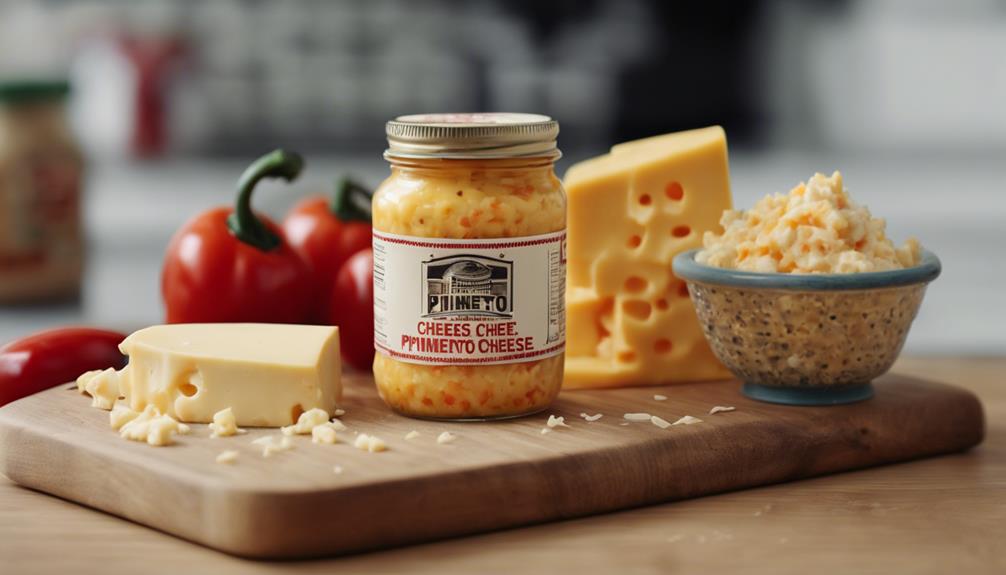
The traditional pimento cheese recipe consists of a classic combination of ingredients, including Cheddar cheese, mayonnaise, cream cheese, and pimentos.
The preparation steps for this beloved Southern spread are relatively simple, making it a popular choice for gatherings and snacks.
Classic Ingredient Combination
Combining shredded extra-sharp Cheddar cheese, mayonnaise, cream cheese, pimentos, and jalapeños creates the base for the creamy and tangy traditional pimento cheese spread.
This classic Southern favorite also incorporates flavorings like garlic powder, cayenne pepper, salt, and pepper to enhance its rich taste profile.
Known as the pâté of the South, pimento cheese is praised for its savory flavor composition. The blend of Cheddar cheese and pimentos results in a distinctive mix of sweet, tangy, and mildly spicy notes that characterize pimento cheese.
Whether enjoyed with crackers, vegetables, or as a filling for pimento cheese sandwiches, this versatile dish holds a special place in Southern cuisine.
The combination of ingredients in pimento cheese showcases the craftsmanship of Southern culinary tradition, offering a delightful harmony of flavors that continue to captivate palates across the region.
Simple Preparation Steps
To prepare the traditional Pimento Cheese recipe, start by blending cream cheese and mayonnaise with Cheddar cheese, pimentos, and spices until smooth. This step is essential in achieving the signature creamy texture and tangy flavor that characterizes this Southern favorite.
The cream cheese and mayonnaise combination provides a rich and velvety base, while the sharpness of the Cheddar cheese adds depth to the mixture. The pimentos contribute a touch of sweetness and vibrant color, enhancing both the visual appeal and taste of the dish.
Homemade Pimento Cheese Variations

For homemade pimento cheese variations, consider experimenting with different cheese types and extra ingredients to elevate the flavors and textures of the classic recipe. By incorporating unique twists into your spread, you can create a personalized version that suits your taste preferences. Here are some ideas to enhance your homemade pimento cheese:
| Homemade Variations | Spice Levels | Flavor Profile |
|---|---|---|
| Diced Jalapeños | Medium | Spicy kick |
| White Cheddar | Mild | Creamy |
| Sriracha Sauce | Hot | Bold and zesty |
Mixing in ingredients like green onions or crispy bacon can add layers of flavor and texture. You can also experiment with different spice levels by adjusting the amount of cayenne pepper or adding smoked paprika for a smoky twist. These variations provide a creative way to enjoy the traditional pimento cheese with a personalized touch.
Serving Suggestions for Pimento Cheese
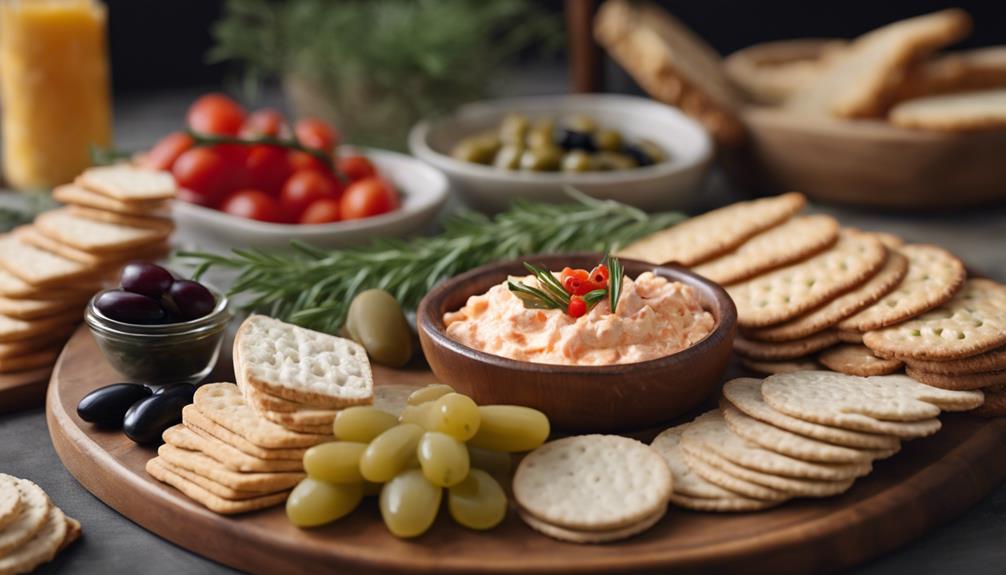
Consider serving pimento cheese as a versatile spread on various accompaniments to enhance your dining experience. This delicious Southern spread can be enjoyed in a variety of ways.
For a classic option, spread it between two slices of bread to create a mouthwatering pimento cheese sandwich. If you're feeling more adventurous, try using it as a filling for a grilled cheese – the creamy and tangy flavors will elevate this traditional dish to a whole new level.
Additionally, pimento cheese can be paired with an array of foods to cater to different tastes. It complements vegetables like celery and carrots, providing a flavorful dip option.
For a more substantial meal, consider using pimento cheese as a topping for baked potatoes or as a side for dishes like fried green tomatoes. The versatility of pimento cheese makes it a perfect choice for gatherings, picnics, or casual get-togethers.
Storing Pimento Cheese Properly
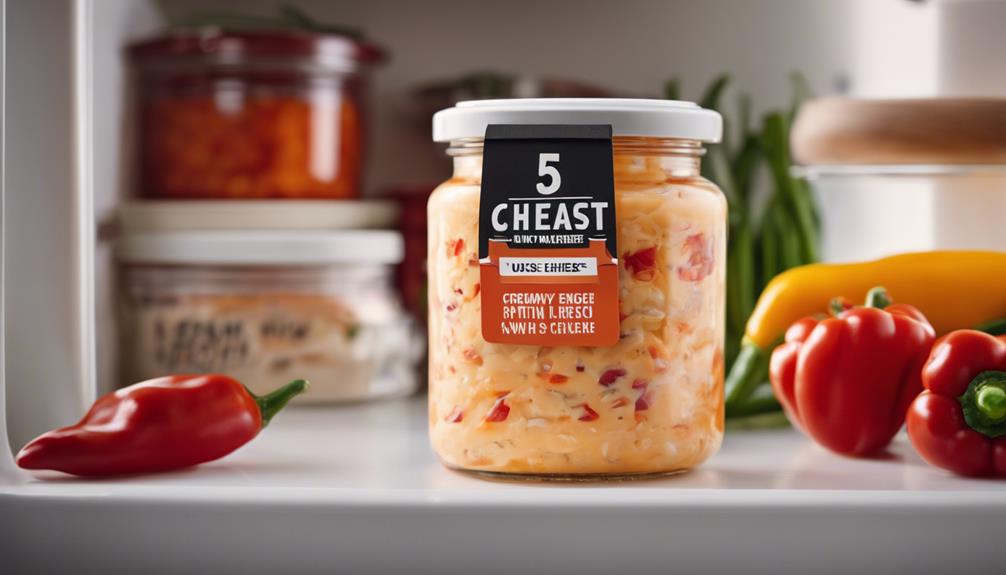
Properly storing pimento cheese guarantees its freshness and flavor for an extended period. To maintain its delicious taste, store your pimento cheese spread in a shallow, airtight container in the refrigerator. This method helps preserve the spread's quality for up to one week. Avoid leaving the pimento cheese at room temperature for too long, as this can lead to spoilage. Make sure the container is tightly sealed to prevent the spread from absorbing other odors in the refrigerator. Here is a helpful table summarizing the key points for proper storage of pimento cheese:
| Pimento Cheese Storage Tips | Location | Duration |
|---|---|---|
| Airtight container | Refrigerator | Up to one week |
| Avoid room temperature | Room temperature | Not recommended |
| Tight seal | Avoid odors | Maintain freshness |
Remember to check for any signs of spoilage, such as off smells or unusual colors, before consuming stored pimento cheese.
Freezing Pimento Cheese Tips
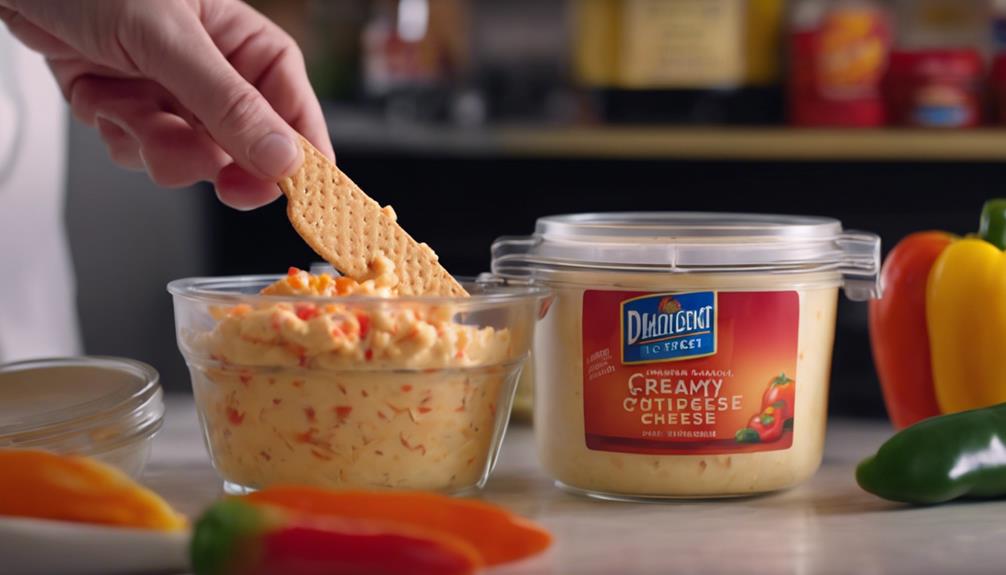
When freezing pimento cheese, it's important to follow proper techniques to maintain its quality.
Portioning the cheese before freezing can make it easier to thaw only what you need.
Remember to thaw frozen pimento cheese in the refrigerator for the best results.
Proper Freezing Techniques
To preserve the quality of pimento cheese when freezing, make sure it is stored in an airtight container. This helps maintain its texture and flavor when you eventually thaw it. Freezing pimento cheese can alter its texture slightly, but the flavor remains intact. When you freeze pimento cheese, consider dividing it into individual portions. This makes it easier to thaw only what you need, preventing unnecessary thawing and refreezing cycles that can impact its taste and consistency.
Proper Freezing Techniques for Pimento Cheese:
| Key Aspect | Details |
|---|---|
| Duration | Up to three months. |
| Texture | May slightly change upon thawing. |
| Flavor | Remains relatively unaffected. |
| Thawing Method | Thaw in the refrigerator for best results. |
Thawing Pimento Cheese
It's essential to thaw your frozen pimento cheese in the refrigerator overnight for best results.
When thawing pimento cheese slowly in the refrigerator, you preserve its texture and flavor.
Although the texture of thawed pimento cheese may vary slightly from fresh pimento cheese, the flavor profile remains unchanged.
It's important to avoid thawing pimento cheese at room temperature to prevent the growth of harmful bacteria.
Before serving, make sure to stir the thawed pimento cheese thoroughly to achieve a consistent texture throughout.
To simplify the thawing process and enhance storage convenience, consider portioning the frozen pimento cheese into smaller containers.
Pimento Cheese Nutritional Information
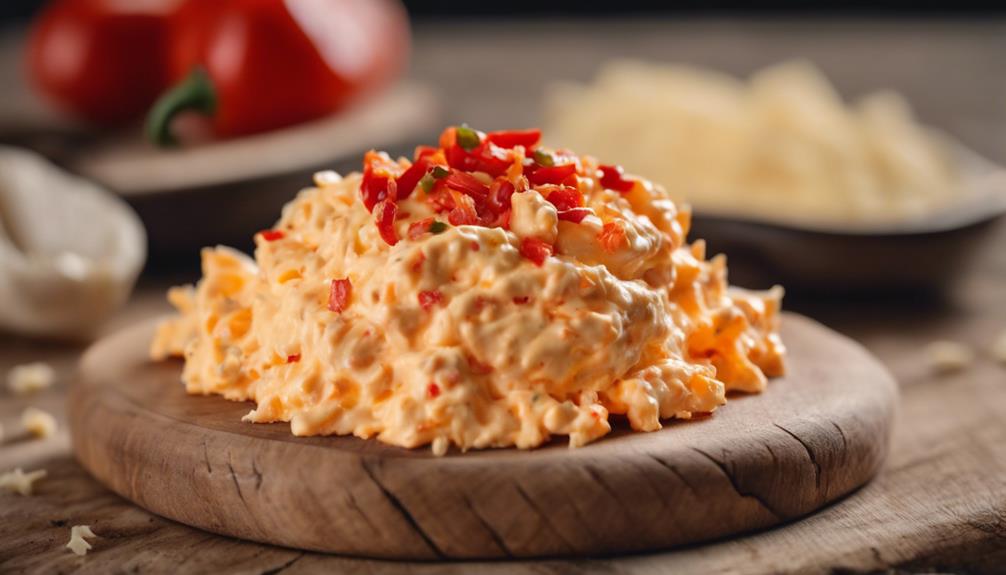
The nutritional profile of pimento cheese highlights its calcium content and saturated fat levels. Pimento cheese contains cream cheese and shredded cheese, contributing to its saturated fat content.
While it provides a good amount of protein, it's essential to be mindful of portion sizes due to its calorie and fat content. A serving of pimento cheese offers approximately 20% of the recommended daily intake of calcium, making it a notable source of this essential mineral.
However, the calorie content in pimento cheese can vary based on the specific ingredients and proportions used in the recipe. Hence, it's important to be aware of the calorie and fat content, especially if you're monitoring your dietary intake.
Enjoy pimento cheese in moderation to savor its creamy and tangy flavors while being mindful of its nutritional components.
Popular Pimento Cheese Pairings
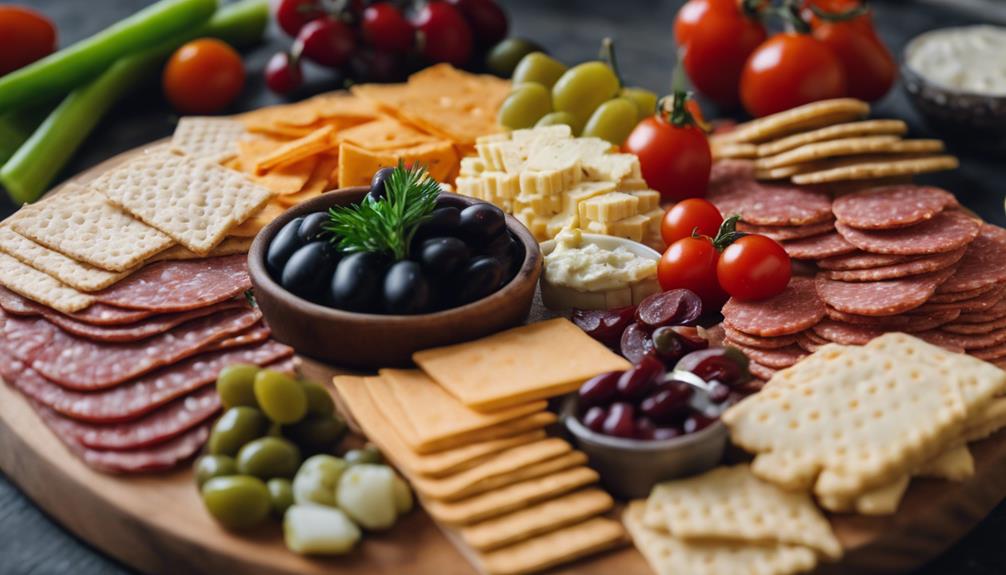
Explore exciting ways to enjoy pimento cheese by discovering its perfect pairings with various foods and dishes. Pimento cheese complements crackers, celery, carrots, and crostini exceptionally well, creating a delightful appetizer spread that's perfect for gatherings or solo snacking.
Additionally, this creamy and tangy spread shines as a filling in sandwiches, particularly when paired with grilled ham and cheese for a comforting and flavorful meal.
For those seeking a more creative culinary experience, consider incorporating pimento cheese into baked potatoes or scrambled eggs to elevate their taste profiles. Another innovative option is mixing pimento cheese with mashed potatoes, resulting in a unique and delicious side dish that's sure to impress.
Furthermore, for enthusiasts of spicy flavors, enhancing pimento cheese with more jalapeños or a touch of Sriracha can provide a fiery kick that adds an extra dimension to this beloved Southern favorite.
Community Favorite Pimento Cheese Recipes
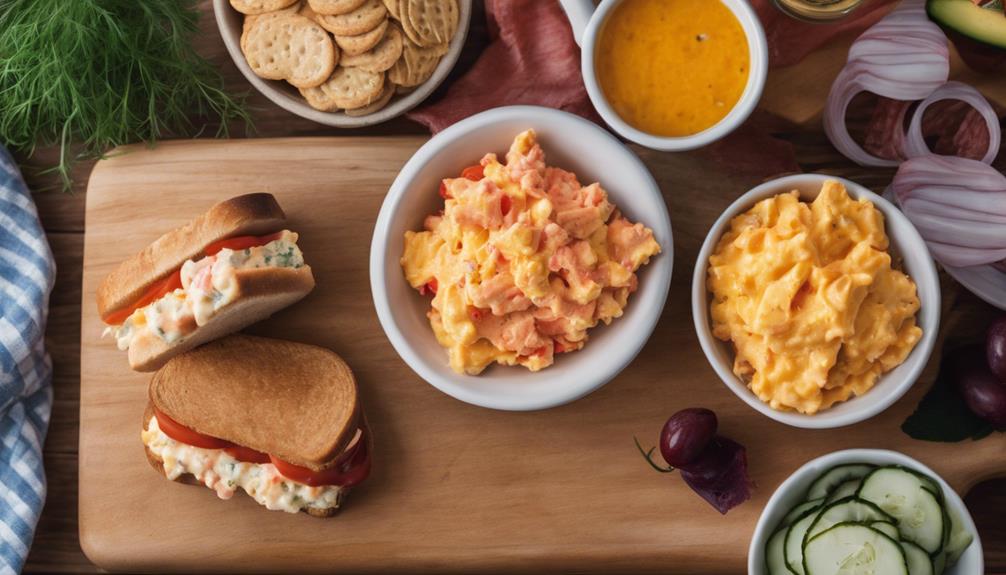
Exploring the world of community favorite Pimento Cheese recipes reveals a myriad of delectable blends that showcase the tangy and creamy essence of this beloved Southern spread. A common feature in these recipes is the use of cream cheese, which makes for a rich and velvety texture.
The Southern pimento cheese recipe often includes a harmonious combination of cream cheese, mayonnaise, sharp cheddar cheese, diced pimentos, and a blend of spices to achieve that signature tangy flavor.
When looking for the best pimento cheese recipe, many enthusiasts recommend specific ingredients such as Dukes Mayonnaise or mild cheddar cheese to enhance the overall taste. In addition, users provide valuable feedback on serving suggestions, storage tips, and unique variations to personalize the recipe according to individual preferences.
This versatility allows pimento cheese to be enjoyed as a dip, spread, sandwich filling, or incorporated into various dishes like omelettes and mac and cheese, showcasing its adaptability in culinary creations.
Frequently Asked Questions
Is Pimento Cheese a Southern Thing?
Yes, pimento cheese is a Southern thing. This creamy and tangy spread made with cheddar cheese, mayo, cream cheese, and pimentos is a beloved staple in Southern cuisine, often enjoyed as a dip, sandwich filling, or snack.
Why Is Pimento Cheese so Popular in South Carolina?
Imagine this: Pimento cheese is as popular in South Carolina as sweet tea on a scorching day. Its creamy, tangy goodness evokes nostalgia and comfort, making it a must-have at every gathering. It's just a Southern thing.
What Is Pimento Cheese Made Of?
Pimento cheese is made of shredded extra-sharp Cheddar cheese, mayonnaise, cream cheese, pimentos, and jalapeños for added flavor. You'll commonly find garlic powder, cayenne pepper, salt, and pepper in pimento cheese recipes, creating a creamy and tangy spread.
What Is the Difference Between Palmetto Cheese and Pimento Cheese?
When comparing Palmetto Cheese to pimento cheese, remember that all Palmetto Cheese is pimento cheese, but not all pimento cheese is Palmetto Cheese. Palmetto Cheese is a specific brand known for its creamy texture and tangy flavor.
Can I Use Pimento Cheese in Festive Appetizers Like Pistachio and Cranberry Goat Cheese Ball?
Yes, you can definitely use pimento cheese in festive appetizers like a pistachio and cranberry goat cheese ball. The creamy and tangy flavors of pimento cheese will add a unique twist to the traditional flavors of the festive pistachio cranberry goat cheese ball. Try it and impress your guests! Simply mix pimento cheese with the goat cheese base to create a delightful fusion of textures and flavors. Roll the mixture in a coating of chopped pistachios and dried cranberries to maintain the signature look of the festive pistachio cranberry cheese ball. This playful twist will not only elevate the presentation but also make it the highlight of your holiday spread! Your guests will love the balance of the rich, cheesy interior and the crunchy, fruity coating, making each bite irresistibly flavorful. Whether you follow a traditional pistachio cranberry cheese ball recipe or create your own variation with pimento cheese, this appetizer is sure to become a seasonal favorite. Serve it with an assortment of crackers, sliced baguette, or fresh vegetables to complete the festive display.
Conclusion
To sum up, pimento cheese is a beloved southern classic known for its creamy texture and tangy flavor. With a rich history and versatile serving options, it continues to be a popular choice for gatherings and events.
Whether enjoyed on its own or paired with crackers or vegetables, pimento cheese offers a unique and delicious taste experience for all who try it.
Explore the world of pimento cheese and discover why it has stood the test of time as a beloved southern favorite.
